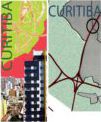Curitiba is the capital city of the State of Paraná in Brazil. For South America and many countries of the world it symbolizes good administration, controlled growth and democratic participation in the government choices about sustainable development.
In recent years the image of Curitiba has been successfully promoted at an international level through catchwords like the “ best planned city”, “the creative city”,” the sustainable city”. And the city has become a very popular icon of sustainable modernity.
Since a few years unexpected problems have emerged. The structure of the city that was innovative in the 1960s is at present unable to successfully cope with several changes that have occurred in recent years, The Curitiba workshop was an opportunity for elaborating on current problems of cities in different regions of the world. Curitiba has been chosen as case study mainly for two aspects:
-as the example of a new well-planned city that has grown rapidly and continues to expand but has lost the original quality. Its new developments are mostly mono-functional residential district
- as an example of the limits of a strong and rigid spatial plan that while on one side has created the backbone of the city, on the other does not allow flexible adjustments to new needs and changes
The workshop offered the opportunity to think about the role the city can play in the future and how it can continuously update itself, adjust to change and be competitive, making reference to its past and without losing its basic characteristics.
Curitiba is a linear city structured by 5 high density axes on which the land use and public transportation systems are based. The surrounding urban area is formed of parts which are different in character: a first “central” older district that has developed where the axes cross, a second part made of low buildings developed around the central core and a third very large peripheral section with a low density and low qua- lity fabric which is interspersed of high density favelas. Migrants arriving from other regions of Brazil and other Latin American countries stay there. This part of the city continues to expand with scarce control. It is an area that has become increasingly marginal both from a spatial and social point of view.
Finally Curitiba has been an excellent laboratory to approach the problem of sustainability of built and green spaces in urban areas, to explore alternative housing policies, to design spaces (and distances among different activities) that are conceived for pedestrians and that are conceived for pedestrians and not for cars, to elaborate on the theme of the preservation of nature and landscape in an urban context. It has also a city where new lpw-cost advanced mass-transit solutions have been developed and implemented. The Bus Rapid Transit (BRT) of Curitiba has been adopted by several mega-cities around the world.
The Laboratory was held in cooperation with IPPUC (Instituto de Pesquisa Planejamento Urbano de Curitiba) and PUC (Pontifical Catholic University of Paraná).
